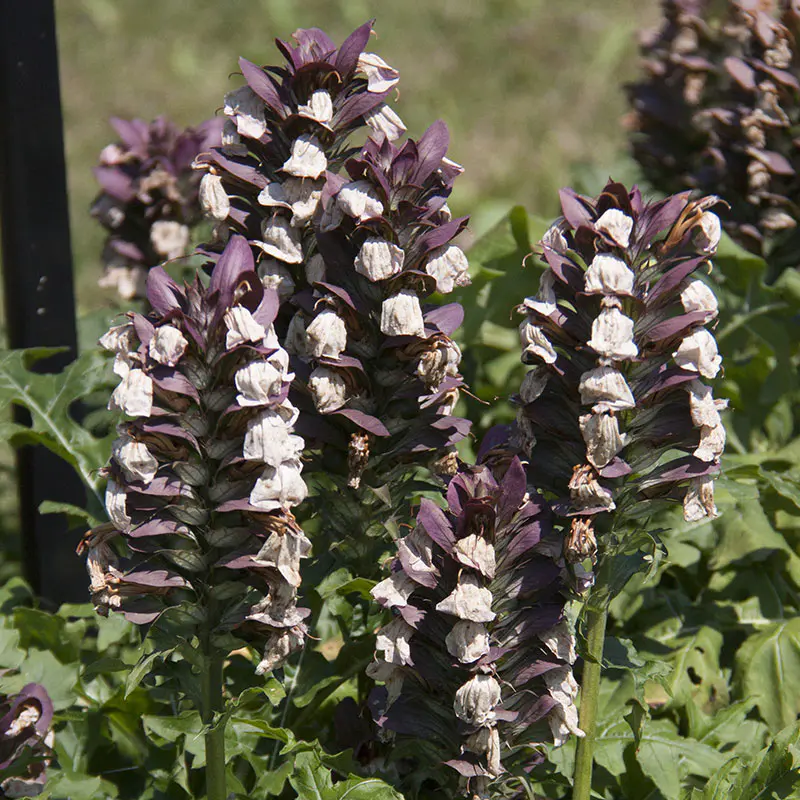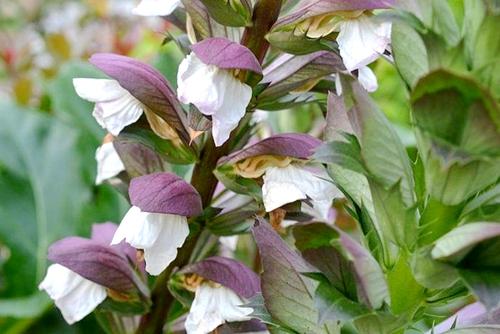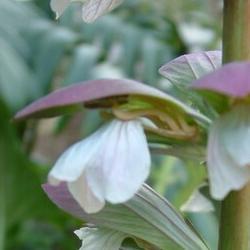How to Grow and Care for Bear's Breeches Plant (Acanthus Mollis)
Written by Maggie
Dec 06 2021

The Bear's Breeches plant (Acanthus Mollis) are evergreen upright subshrub clusters. What is the plant known as the bear's breeches? How to grow and care for bear's breeches plant? Let's find out together.
Bear's Breeches Quick Info
| Botanical/Scientific Name | Acanthus Mollis |
| Common Name | Bear's Breeches |
| When to Grow/Bloom/Harvest | Grow in spring/Bloom in late spring to mid summer |
| Uses | Used as a treatment for dislocated joints and for burns |
| Origin | Southern Europe |
| Light Care | Partial shade |
| Soil Care | Rich soil with proper drainage |
| Temperature Care | 10 to 15 degrees Celsius (50 to 59°F |
| Humidity Care | Moisture |
| Watering | Best with regular water |
| Pruning Care | Be cut back after flowering |
| Fertilizer Care | Balanced fertilizer |
| Propagation | By root cuttings |
| Toxic | No toxic |
| Flower Color | Purple White Pink |
When to Plant Bear's Breeches
The suitable planting time of the bears Breeches plant is about late July. When sowing bear's crops, we can level the seedbed, pour water through it, mix seeds evenly with fine sand, cover it with fine soil after sowing, and then cover it with wet straw for moisture, which is conducive to seedling emergence. After 60% emergence, remove the grass cover, and then cover it with shading net to cool and moisturize the seedlings.When does Bear's Breeches Bloom & Harvest
Bear's Breeches bloom from May to August. Bear's Breeches has huge leaves, thick spikes and large flowers. Bear's Breeches has two calyx petals, with purple and green transition. The upper calyx is long and oval, as big as a cover, which means very obvious protection for the stamens and petals under it. The lower calyx is small, covered by the petals, and can hardly be seen. Bear's Breeches petals are pink and soft.Read More:
Bears breeches (Acanthus mollis) profile
Bear's Breeches Care in Detail
Bear's Breeches Humidity Requirements
Bear's breaches plant likes warm and humid climate, is not resistant to cold and frost, and is more resistant to shade. Its leaves are easy to burn under direct light. Bear's breaches likes loose, fertile and sandy loam with good drainage.Bear's Breeches Pruning
After Bear's Breeches grow normally, they should pay attention to management and help them grow new branches. When they can pick the heart, they should prune to make it more branched. Then you can fill the basin in a fixed position. When the new branches grow to a certain length after the basin, you can remove the terminal buds, so that the branches and leaves can be scattered to obtain a drooping branch shape, which looks more beautiful and artistic.Bear's Breeches adopts pruning when the plant does not grow in vain, and the terminal buds can be removed one by one. In this way, not only the plant type will look good, but also the branches will become thick and lignified, which is conducive to resist diseases, but also support the weight of the whole Pearl branches. The most important thing is that this increases the number of flowers.
Bear's Breeches Repotting
Bear's Breeches repotting is best carried out in spring. After March, it is mainly after flowering or after cool autumn. It is ideal to change pots in these two periods.We can take bears Breeches plant from the original pot. The root system of the plant grows too long in the pot. The root system mainly grows in the area where the soil contacts the flower pot, and the old root should be cut off with scissors or knife. Remove one third of the original soil ball from the periphery, and the whole soil cannot be removed, otherwise the root system is difficult to recover. Then put a bug net on the drain under the bear's Breeches flowerpot. If it is a breeding seedling, you can change a larger basin.
We can put a cm of soil on the bottom of bear's Breeches flowerpot, add a little rotten organic fertilizer or slow-release compound fertilizer, and then cover it with a cm of soil. We should put the original soil ball with the outer roots removed in the center of the flowerpot and start filling. When the soil is filled to half the height of the flowerpot, lift the original flower ball up so that the original flower ball is three to four fingers lower than the flowerpot. Then fill the soil evenly, adjust the flower ball so that bear's Breeches plant is just in the center of the flower pot, compact the newly filled soil, pour water, and place it in a cool and ventilated place for two to three days.
Bear's Breeches Light & Temperature Care
These flowers experience the daylight in moderation.
In their herbal habitat, these vegetation acquire hundreds of herbal lights.
When we grow and care for bear's breeches, to make sure these backyard vegetation continue to be wholesome and bloom well, it is necessary to make them positive so they obtain a few hours of sun.
They typically do nicely in full solar to partial shade.
While these vegetation require sunlight, they want extra safety in hotter climates.
It is recommended to shield these flowers from the warm afternoon sun.
Keep in mind that, sometimes, Acanthus can go dormant in the late summer.
However, as soon as the temperature drops a bit, these plant life will rapidly soar returned to life
Bear's Breeches Watering & Fertilizer Care
Once established, Acanthus breech vegetation is one of the hardy flora and incredibly resistant to drought.
However, it is really useful to stick to normal watering. Water flora as soon as or twice a week.
An inch of water a week has to do the trick. It will additionally make positive that you don't overwater and drown the roots.
Bear's breeches are now not heavy feeders. When we grow and care for bear's breeches, apply fertilizer throughout the flowering season (spring or mid-summer).
Use a balanced fertilizer and practice it solely if the plant appears like it wishes some.
Soil for Bear's Breeches
- Bear breeches revel in prosperous soil. The extra compost or natural fabric introduced the happier these plant life will be.
- This is in particular necessary for younger plants.
- Once installed the plant can thrive in bad soil as well.
- However, it is honestly indispensable to make certain that the soil is well-drained.
- Otherwise, the roots may additionally rot, particularly at some point of the bloodless wintry weather months of the year.
- The most suitable pH stage of the soil tiers from 6.5 to 7.5.
Bear's Breeches Pest & Disease Control
Aphid Disease Control
1. Use the smell that aphids likeSpecific measures: we can use sweet and sour wine (white sugar to be boiled with hot water, water can not be too much, add vinegar and wine, and can smell sweet) can be put into Baijiu small cup or drink small cup of medicine, until the aphid is active in the evening, put it next to Bear's Breeches. We can also use willow strips, rub them, tie them up, lure a large number of aphids, and then kill them in a concentrated way. It is applicable to large areas with serious disasters. Because bear's Breeches plant has a certain defense ability, there is no need to worry about the harm of a small number of aphids.
2. Plant ash water
We can use plant ash (which can be burned with hay and the remaining ash after burning) and water to soak it in a ratio of 1:5. It is more convenient to spray it where there are aphids in the affected plants. And it can supplement potassium fertilizer to kill two birds with one stone.
Using the phototaxis of aphids to use black light lamp is suitable for any occasion. It can not only kill aphids, but also avoid other bear's Breeches pests.
3. We can also use irritant pepper water and pepper water, take a certain amount of dry pepper or pepper, boil it in boiling water until the water changes color, take out the impurities after the water cools, and then spray the pepper (pepper) water on the injured plants. The effect is obvious.
4. Use insecticides
1g urea, 1.25g washing powder and 100ml water are added to make a small nozzle for liquid medicine, but it can not be used too frequently.
Scale insect Disease Control
When we find scale insects on individual bears Breeches plant leaves or branches, we can gently brush them with a soft brush or wipe them off with cotton balls and cloth balls, or cut off the insect leaves and branches in combination with pruning. It is required to brush, cut and burn them in a centralized manner, and do not litter them;In case of large scale insects, chemicals shall be used for control, mainly focusing on spraying during the incubation period of eggs, because at this time, the scale has not formed or thickened, and the drugs shall be killed. If the wax shell has formed, the spraying effect is not good.
For the prevention and treatment of bear's breeches, 40% Omethoate, 50% malathion, 25% imithion emulsion and 80% dichlorvos emulsion 1000 times can be used. They can be sprayed every 7 to 10 days for 2 to 3 consecutive times.

Bear's Breeches Propagation
The Bear's Breeches can be propagated by seeds, cutting, and division.Bear's Breeches Propagation from Cutting
Bears Breeches plant can be propagated from cutting. After 40 days, the rooting rate can reach about 75%. We can move bear's Breeches indoors in mid October. The room temperature is not lower than 8 degrees Celsius and will not be frozen. Move to the outdoor in late April of the next year, and cut all flowers short to promote the surface of pus buds at the base and draw new flower branches. After 2-3 years, the clumps will be dense year by year, and the old prostitutes should be thinned according to the situation. If the root system does not arch out of the basin soil, try not to turn the basin for soil, and supplement nutrition through topdressing.Bear's Breeches Propagation from Seeds
Keep in thinking that below the proper conditions, Bear's Breeches may also propagate vigorously on its own. When developing from seeds, spring is the satisfactory time to sow the seeds. However, Acanthus mollis grown from seeds can also take years to bloom.
Bear's Breeches Propagation from Division
Division is one of the extra favored methods. Since these flora have lengthy faucet roots, the satisfactory way to divide them is to thrust a shovel in the plant’s roots throughout fall.
By spring, the roots will develop a variety of child flora that can be transplanted besides inflicting harm to the mother or father plant.
On the other hand, if you desire to propagate flowers thru cuttings, it is recommended to root cuttings in spring or fall.
While Acanthus mollis is resistant to most insect attacks, powdery mildew and different fungal ailments can cause serious troubles for these plants.
The best way to deal with this trouble is to supply correct air circulation and use a good-quality fungicide.

Bear's Breeches Plant Benefits
Bear's Breeches plant has lush stems and leaves, unique flower shape and long flowering period. It is a good basic planting material. Bear's Breeches plant has large leaves, oil green and beautiful flower pavilions. Potted plants are suitable for viewing on balconies and rooftops. They can be planted on the roadside, in front of windows or in flower beds in the courtyard; It can be used for cultivation and appreciation of garden green space. Bear's breeches are suitable for planting under the south window, in front of the fence, beside the steps, on the roadside, etc.
Latest Updated
- Benefits of Bugleweed - 7 Science-backed Health Benefits
- Bugleweed Dangers & Side Effects - Is It Poisonous?
- How to Plant Evergreen Trees - What You Should Know
- When to Plant Evergreens - Grow Guide for Evergreen Trees
- 12 Wonderful Evergreen Shrubs for Your Garden
- 12 Popular Evergreen Plants with Pictures for Beginners
- When And How To Prune A Lilac Bush Like a Pro
- How to Grow & Care for Lilac Vine (Hardenbergia Violacea)
- Japanese Lilac Tree (Syringa Reticulata) Care & Propagation Guide
- Shumard Oak Pros and Cons - What to Know
Popular Articles
- Winter maintenance of Antirrhinum Majus
- How to Grow Terminalia Mantaly Tree
- How to Grow and Care for Crossostephium Chinense
- How to grow Antirrhinum Majus in spring
- Peristeria Elata (Dove Orchid) Profile: Info & Care Guide
- Underwatered Snake Plant (Sansevieria Trifasciata) - Signs And How To Fix
- How to Care for Brazilian Jasmine Plant (Mandevilla Sanderi)
- How to Grow & Care for Graptopetalum Purple Delight in Summer
- Rosa Chinensis (China Rose): Plant Growing & Care Tips
- How to Care for Baby Sun Rose (Aptenia Cordifolia)